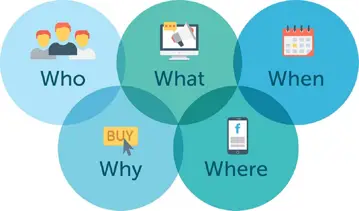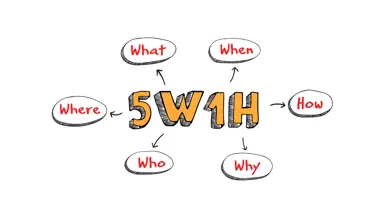The understanding of 5W1H: Meaning and Application of the Concept
Have you ever wondered, 'What is 5W1H?' This intriguing concept encompasses six fundamental questions that serve as powerful tools for unraveling complexities and gaining deeper insights into various aspects of life, work, and problem-solving.
In this article, Aniday will explore the meaning and practical applications of 5W1H, shedding light on how it can be a game-changer in your quest for understanding and decision-making
What is 5W1H?

At the outset, let's decode the enigma of "What is 5W1H?" 5W1H stands for six essential English words: What, Where, When, Why, Who, and How.
These fundamental questions serve as invaluable tools for exploring and comprehending problems, events, phenomena, or activities thoroughly. By accurately addressing these inquiries, one can dissect the causes, objectives, entities, methods, and outcomes pertaining to the subject at hand.
Interpretation of 5W1H

Now that we've familiarized ourselves with "What is 5W1H?", let's delve into its interpretation:
1. What
The first "W" in 5W1H signifies "What." It lays the foundation for understanding the issue or task at hand. Without a clear comprehension of what needs to be accomplished, progress in subsequent steps becomes untenable. For instance:
- What is the problem?
- What is the objective?
- What is the product?
2. Where
"Where" questions pinpoint locations or areas associated with a matter or activity. They aid in surveying the market, customers, competitors, or resources relevant to a project or business campaign. Examples include:
- Where is the target market?
- Where are the customers?
- Where are the competitors?
3. When
"When" inquiries establish the timing, moments, or deadlines linked to an issue or endeavor. These questions facilitate planning, task allocation, and progress monitoring. For instance:
- When is the deadline?
- When is the optimal product launch time?
- When is the peak season?
4. Why
"Why" queries probe into the reasons, causes, or purposes behind a problem or activity. They aid in identifying the root issue, core values, and benefits of a project or business campaign. Examples include:
- Why did the problem occur?
- Why is this action necessary?
- Why do customers choose our product?
5. Who
The "Who" question identifies the individuals, groups, or organizations involved in an issue or activity. It sheds light on roles, responsibilities, and stakeholders' interests in a project or business campaign. For example:
- Who is responsible for this?
- Who comprises the target customer base?
- Who are our partners?
6. How
"How" questions uncover the methods, tools, or strategies pertinent to an issue or activity. They aid in designing, implementing, and assessing the effectiveness of a project or business campaign. For instance:
- How do we resolve the problem?
- How should we promote the product?
- How do we measure the results?
Applications of 5W1H in the Field of Marketing

In the realm of marketing, the application of "What is 5W1H?" abounds in various activities, including:
- Market Research: Utilize 5W1H to gain insights into target customers, their needs, buying behaviors, and influencing factors.
- Strategic Planning: Harness 5W1H to define marketing goals, conduct SWOT analysis, select media channels, allocate budgets, and measure effectiveness.
- Content Design: Leverage 5W1H to craft compelling and informative content that addresses potential customer queries.
- Result Evaluation: Utilize 5W1H to assess campaign performance using metrics like lead count, conversion rates, revenue, and customer satisfaction.
Applications of 5W1H in Business
Beyond understanding "What is 5W1H?" and its marketing applications, consider the broader significance of 5W1H in business activities:
- Project Management: Employ 5W1H to plan projects by delineating scope, timeframes, budgets, personnel, risks, and success criteria.
- Problem Solving: Apply 5W1H to analyze issues, discern root causes, impacts, and possible solutions.
- Quality Improvement: Utilize 5W1H to enhance product or service quality by detecting and rectifying errors, defects, or inconveniences.
- Learning and Development: Employ 5W1H for self-improvement and organizational growth by identifying strengths, weaknesses, opportunities, challenges, goals, and necessary actions.
In conclusion, the power of "What is 5W1H" lies in its ability to serve as a guiding framework, illuminating the path to understanding, problem-solving, and achieving success in various aspects of life, from marketing strategies to business endeavors.
By embracing the six fundamental questions What, Where, When, Why, Who, and How we unlock the keys to unraveling complexities, Aniday hopes this article is helpful to you.
Aniday's HR Services
Headhunting Service
Find and recruit quality candidates in just 1 week! Supported by 40,000 experienced headhunters in IT, Finance, Marketing… capable of recruiting in any region.
Headhunting Service ➔Employer of Record (EOR) Service
On behalf of your business, we recruit employees and handle payroll without the need to establish a company in markets such as Vietnam, Singapore, Malaysia, India, Indonesia…
Employer of Record (EOR) Service ➔